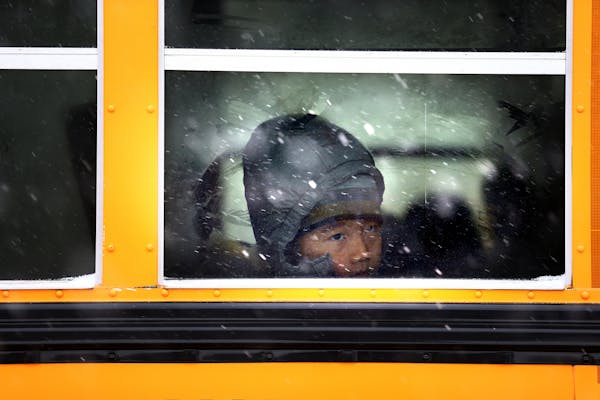OK, well, that wasn't so bad — for now, at least.
The expected whopper of a winter storm that forecasters warned could dump 8 to 12 inches of snow on Twin Cities streets and highways deposited much less by Tuesday, allowing St. Paul and Minneapolis to dodge a one-two punch of deep snow followed by an expected deep freeze.
But commuters — and their roads — aren't quite in the clear yet.
While most of the main arterial roads in Minneapolis and St. Paul were cleaned to the pavement by Tuesday afternoon, snowplow crews kept rolling to clear all that they could before cold weather forecast for later this week solidifies the snow and ice yet to be removed and transforms streets into car-rattling, washboard-like thoroughfares.
And the side streets? Since neither major city declared a snow emergency Monday, plows left most residential streets alone. That could mean a bumpy ride on those roads for a week or more, public works officials said.
Mike Kennedy, Minneapolis' director of transportation, maintenance and repair, said that as of Tuesday afternoon, the city's major streets were in fair condition for driving and the residential streets in poor condition. But he said the snow was too light to warrant declaring a snow emergency, meaning most residential streets won't be plowed. He said that to declare a snow emergency usually requires at least a 4-inch snowfall, although the city has done so with less snow, or held off plowing after bigger snowfalls if the weather was expected to warm quickly.
That's not likely to happen this week, with freezing temperatures forecast for the foreseeable future. Kennedy said that the Tuesday morning sun was melting snow along arterials where salt and sand had been applied, but the refreezing overnight could turn some spots slick by Wednesday morning's rush-hour commute.
In St. Paul, Doug Drusch, plow operations chief, said a pre-emptive strike with rock salt on Sunday allowed crews to clear most of the city's main roads Monday and Tuesday. Officials estimated that 75 to 80 percent of the city's busier streets were clear by Tuesday afternoon; they were working on getting to the rest Tuesday night.
"I want to get most of the slushy stuff before it freezes," he said.
But with less than 3 inches of snow across much of the city, the side streets — much like in Minneapolis — weren't cleared and probably won't be.
The resulting washboard effect — caused by small, compacted ruts of snow freezing — is unlikely to be affected by plows designed to push snow out of the way rather than cut through ice.
"You need Mother Nature to really get rid of that," Drusch said.
And Mother Nature appears to be taking her time. By next week, January-like temperatures are expected to descend upon Minnesota, with highs in the upper teens and lows that could fall below zero, said meteorologist Paul Douglas.
'A long winter'
This week's blast of midwinter conditions was a pretty rude awakening for public works crews that were in the middle of autumn street-sweeping when they had to transform trucks into snowplows on the fly.
"I think it's going to be a long winter," Drusch said.
Heading into Monday, forecasters were predicting the possibility of 14-plus inches of snow. Actual snowfall amounts varied widely, with the heaviest snowfall landing north of the Twin Cities. Cambridge got buried in 16.5 inches of snow, but Minneapolis-St. Paul International Airport recorded just 2.6 inches. Lakeville barely had enough snow to cover the still green blades of grass.
All of that had some public works officials breathing a sigh of relief Tuesday. Coming on the heels of last winter, when deep snows were followed by deep freezes that kept most streets icy and bone-jarring for months, many residents were worried, said St. Paul City Engineer John Maczko.
But, he said Tuesday, "the residential streets are very passable and drivable," adding that crews were sanding residential streets that are especially problematic.
In some ways, Maczko said, Twin Cities residents are a bit spoiled by crews that keep roads open even in the worst of storms, some of which would shut down other metropolitan areas. As long as cars keep driving and compacting snow, he said, there will be spots that are tough to clear.
"Other cities are shut down by storms; ours are not," Maczko said. "We have kind of raised that level of expectation, that level of service."
James Walsh • 651-925-5041 Steve Brandt • 612-673-4438
8 months in jail for Blaine man who caused 120-mph crash hours after he was caught speeding

Daughter sues St. Paul, two officers in Yia Xiong's killing

